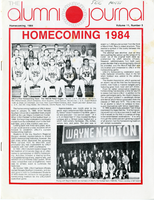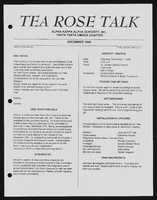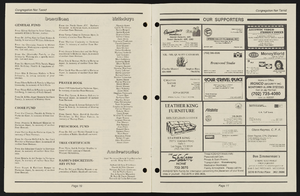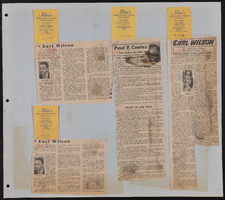Search the Special Collections and Archives Portal
Search Results

McDonald's Neon Survey document, September 17, 2017
Date
Archival Collection
Description
Site address: 3475 S Las Vegas Blvd
Sign owner: Mcdonalds Restaurant of NV 04873 Mcdonalds USA, LLC and Harrah's Las Vegas LLC
Sign details: Part of Harrahs property
Sign condition: 5 - great condition, fully functional seems well kept up
Sign form: Back to Back architectural sign
Sign-specific description: Large arch that rests on the side of the building playing off the name "golden arches" for Mcdonald's, a small cabinet sits on the middle of the sign with the full name of Mcdonalds and a small M on the edge of the cabinet. The arch is yellow covered in yellow neon tubing, the cabinet is red with white lettering for the name, the name in white, small M is yellow. The Neon tubing is animated in the sense it will flash on and off and then chase up the arch towards the building, the words and the M stay lit at all times. The sign is on even during the day as shown in many youtube videos. It also has a red base on the sidewalk where guests walk by with another small M in yellow. It looks like the lettering for Mcdonald's and the M are made of plastic and are internally lit.
Sign - type of display: Neon, incandescent bulbs
Sign - media: Steel, fiberglass/plastic
Sign animation: Yes, neon flashes on and off then chases up the archway to meet in the middle: https://www.youtube.com/watch?v=vQcsd2-GdfY&t=2922s (21 minutes in)
Sign environment: Casino Resorts
Sign - thematic influences: No particular theme except for a play on the name "Golden Arches", probably made to look like the rest of the large neon signs on the strip, their take on "Las Vegas Signage".
Sign - artistic significance: Typical large and bright las vegas signage
Survey - research locations: Museum
Survey - other remarks: Almost no information on this location
Surveyor: Danny Jacobs
Survey - date completed: 2017-09-17
Sign keywords: Architectural; Neon; Incandescent; Steel; Fiberglass; Plastic; Flashing; Chasing; Back to back
Text

UNLV Alumni Journal, Volume 11, Number 5
Date
Archival Collection
Description
Volume 11, number 5 edition of the University of Nevada, Las Vegas "The Alumni Journal."
Mixed Content

Transcript of interview with Fred B. Houghton by Philip Partridge, February 9, 1975
Date
Archival Collection
Description
On February 9, 1975, Philip Partridge interviewed former attorney, Fred B. Houghton (born August 27th, 1894 in Chicago, Illinois) in his home in Las Vegas, Nevada. The two discuss how Houghton first moved to Las Vegas and how he came to practice law. The interview concludes with Houghton’s thoughts of Southern Nevada.
Text

Alpha Kappa Alpha Sorority, Theta Theta Omega Chapter "Tea Rose Talk" newsletters
Date
Archival Collection
Description
From the Alpha Kappa Alpha Sorority, Incorporated, Theta Theta Omega Chapter Records (MS-01014) -- Chapter records file.
Text

Dana Su Lee oral history interview: transcript
Date
Archival Collection
Description
Oral history interview with Dana Su Lee conducted by Stefani Evans, Vanessa Concepcion, and Cecilia Winchell on February 10, 2021 for Reflections: The Las Vegas Asian American and Pacific Islander Oral History Project. Dana talks about her childhood growing up in California and her parents who were both born in China. She discusses her educational background and her move to Las Vegas with her husband in 1997. Dana also shares her various community and philanthropic pursuits related to education and the arts. Subjects discussed include: Greg Lee; otherness; Nevada Women's Philanthropy (NWP)
Text

Transcript of interview with Ray Keith by David Alexander, March 3, 1980
Date
Archival Collection
Description
On March 3, 1980, David Alexander interviewed community volunteer, Ray Keith (born October 1st, 1911 in Montgomery, Alabama) in her home in Las Vegas, Nevada about her life and memories of Southern Nevada. The two discuss how Keith first arrived in Las Vegas and the addresses that she has lived at. The interview concludes with Keith explaining how she helped to charter the “Home of the Good Shepherd” housing facilities with local Las Vegas women in the sixties.
Text

Transcript of interview with Juanita Kilburg by Vincente C. Camacho, March 7, 1981
Date
Archival Collection
Description
On March 7, 1981, Vicente C. Camacho interviewed accounting clerk, Juanita Kilburg (born September 25th, 1923 in Los Angeles, California) on the second floor of the UNLV Dickinson Library. Kilburg explains how her family first moved to Southern Nevada and her father’s ties to the railroad. She then goes on to explain the growth of the military and Nellis Air Force Base. The interview concludes with a discussion on her work with the American Legion service organization.
Text

Transcript of interview with Joe Lappin by Gordon Brusso, March 4, 1976
Date
Archival Collection
Description
On March 4, 1976, Gordon Brusso interviewed former miner, Joe Lappin (born November 14th, 1914 in Santa Paula, California) about his life in Boulder City, Nevada. The two discuss his early occupational history and his work for the Bureau of Mines. He then goes on to explain the different housing systems that developed in Boulder City during World War Two.
Text


